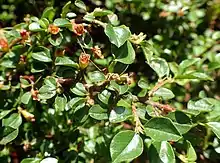| Cotoneaster cochleatus | |
|---|---|
 | |
| 'Schneider' cultivar | |
 | |
| Habit | |
| Scientific classification | |
| Kingdom: | Plantae |
| Clade: | Tracheophytes |
| Clade: | Angiosperms |
| Clade: | Eudicots |
| Clade: | Rosids |
| Order: | Rosales |
| Family: | Rosaceae |
| Genus: | Cotoneaster |
| Species: | C. cochleatus |
| Binomial name | |
| Cotoneaster cochleatus (Franch.) G.Klotz | |
| Synonyms[1] | |
| |
Cotoneaster cochleatus, the Yunnan cotoneaster, is a species of flowering plant in the family Rosaceae.[2][3] It is native to rocky slopes in Tibet, Sichuan, and Yunnan in China, and it has been introduced to the United Kingdom, Belgium and New York State.[1] Its specific epithet cochleatus refers to its twisting stem.[4]
A drought-tolerant creeping shrub reaching 1 ft (0.3 m) tall but spreading to 6 ft (2 m), and hardy in USDA zones 5 through 7, it is considered a valuable landscaping plant by the Missouri Botanical Garden.[5] The Centre for Agriculture and Bioscience International lists it in its Invasive Species Compendium.[6] With its small glossy leaves, tiny rose-like flowers, showy red fruit, and low growth habit, it has found use in bonsai.[5]
References
- 1 2 "Cotoneaster cochleatus (Franch.) G.Klotz". Plants of the World Online. Royal Botanic Gardens, Kew. Retrieved 13 June 2022.
- ↑ "Cotoneaster cochleatus (CTTCC)". EPPO Global Database. European and Mediterranean Plant Protection Organization. 2022. Retrieved 14 June 2022.
Cultivated as an ornamental and naturalized at least in Britain
- ↑ "Cotoneaster cochleatus". The Royal Horticultural Society. 2022. Retrieved 14 June 2022.
Synonyms; Cotoneaster microphyllus var. cochleatus (Franch.) Rehder & E.H. Wilson Cotoneaster melanotrichus misapplied ... 4 suppliers
- ↑ Gledhill, David (2008). The Names of Plants (Fourth ed.). Cambridge; New York: Cambridge University Press. p. 113. ISBN 9780521685535.
- 1 2 "Cotoneaster cochleatus". Plant Finder. Missouri Botanical Garden. Retrieved 14 June 2022.
- ↑ "Datasheet Cotoneaster cochleatus". Invasive Species Compendium. CAB International. 2022. Retrieved 14 June 2022.